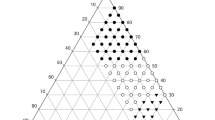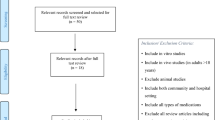Abstract
Purpose
Because of its poor solubility in acidic solution, oral absorption and efficacy of meloxicam (MEL) may be reduced in severe pain patients with impaired gastric motility. The present study aimed to develop salt forms to overcome these drawbacks.
Method
Upon MEL salt screening with eight counterions, five MEL salts were obtained. The physicochemical properties of these MEL salts were characterized with a focus on morphology, crystallinity, thermal behavior, dissolution, and chemical/photo-stability. Pharmacokinetic profiling of an orally administered MEL salt was also carried out in both normal rats and rats treated with propantheline for the suppression of gastric motility.
Results
Dissolution behaviors for all obtained MEL salts were markedly better than that of crystalline MEL; in particular, the initial dissolution rate of arginine MEL dihydrate (MEL/Arg) was ca. 14-fold higher than that of crystalline MEL. MEL/Arg was found to be chemically and physically stable. There was ca. 18-fold reduction of AUC0–4 for orally dosed crystalline MEL (1.0 mg-MEL/kg) in propantheline-treated rats compared with that in normal rats. In contrast, there was only a ca. 3-fold difference in AUC0–4 between normal and propantheline-treated rats after oral administration of MEL/Arg (1.0 mg-MEL/kg).
Conclusion
From these findings, MEL/Arg may provide improved oral absorption in severe pain patients.






Similar content being viewed by others
Abbreviations
- ANOVA:
-
analysis of variance
- Arg:
-
L-arginine
- AUC:
-
area under the curve of plasma MEL concentration versus time
- Cmax :
-
maximum concentration
- DEA:
-
diethanolamine
- DTA:
-
differential thermal analyses
- Gly:
-
glycine
- Lys:
-
lysine
- MEL:
-
meloxicam
- NMR:
-
nuclear magnetic resonance
- NSAID:
-
non-steroidal anti-inflammatory drug
- PLM:
-
polarized light microscopy
- RH:
-
relative humidity
- SD rats:
-
Sprague-Dawley rats
- SEM:
-
scanning electron microscopy
- TEA:
-
triethanolamine
- TGA:
-
thermogravimetric analysis
- Tmax :
-
time to maximum concentration
- Tris:
-
tris(hydroxymethyl)aminomethane
- UPLC/ESI-MS:
-
ultra-performance liquid chromatography equipped with electrospray ionization mass spectrometry
- UV:
-
ultraviolet
- XRPD:
-
X-ray powder diffraction
References
Furst DE. Meloxicam: selective COX-2 inhibition in clinical practice. Semin Arthritis Rheum. 1997;26:21–7.
Hosie J, Distel M, Bluhmki E. Meloxicam in osteoarthritis: a 6-month, double-blind comparison with diclofenac sodium. Br J Rheumatol. 1996;35:39–43.
Aoki T, Yamaguchi H, Naito H, Shiiki K, Izawa K, Ota Y, Sakamoto H, Kaneko A. Premedication with cyclooxygenase-2 inhibitor meloxicam reduced postoperative pain in patients after oral surgery. Int J Oral Maxillofac Surg. 2006;35:613–7.
Ghorab MM, Abdel-Salam HM, El-Sayad MA, Mekhel MM (2004) Tablet formulation containing meloxicam and beta-cyclodextrin: mechanical characterization and bioavailability evaluation. AAPS PharmSciTech 5: article 59
Boyle R, Behan PO, Sutton JA. A correlation between severity of migraine and delayed gastric-emptying measured by an epigastric impedance method. Br J Clin Pharmacol. 1990;30:405–9.
Kulmatycki KM, Jamali F. Drug disease interactions: role of inflammatory mediators in pain and variability in analgesic drug response. Int J Pharm Pharm Sci. 2007;10:554–66.
Serajuddin AT. Salt formation to improve drug solubility. Adv Drug Deliv Rev. 2007;59:603–16.
Rasenack N, Muller BW. Micron-size drug particles: common and novel micronization techniques. Pharm Dev Technol. 2004;9:1–13.
Serajuddin AT. Solid dispersion of poorly water-soluble drugs: early promises, subsequent problems, and recent breakthroughs. J Pharm Sci. 1999;88:1058–66.
He CX, He ZG, Gao JQ. Microemulsions as drug delivery systems to improve the solubility and the bioavailability of poorly water-soluble drugs. Expert Opin Drug Deliv. 2005;7:445–60.
Alnemri ES, Livingston DJ, Nicholson DW, Salvesen G, Thornberry NA, Wong WW, Yuan J. Human ICE/CED-3 protease nomenclature. Cell. 1996;87:171.
Han HK, Choi HK. Improved absorption of meloxicam via salt formation with ethanolamines. Eur J Pharm Biopharm. 2007;65:99–103.
NationalToxicologyProgram. NTP toxicology and carcinogenesis studies of diethanolamine (CAS No. 111-42-2) in F344/N rats and B6C3F1 mice (dermal studies). Natl Toxicol Program Tech Rep Ser. 1999;478:1–212.
NationalToxicologyProgram. NTP toxicology and carcinogenesis studies of triethanolamine (Cas No. 102-71-6) in B6C3F1 mice (dermal studies). Natl Toxicol Program Tech Rep Ser. 2004;449:1–298.
Jamali F, Aghazadeh-Habashi A. Rapidly dissolving formulations for quick absorption during pain episodes: ibuprofen. Int J Clin Pharmacol Ther. 2008;46:55–63.
Bagarozzi Jr DA, Potempa J, Travis J. Purification and characterization of an arginine-specific peptidase from ragweed (Ambrosia artemisiifolia) pollen. Am J Respir Cell Mol Biol. 1998;18:363–9.
Banks WA, Kastin AJ, Komaki G, Arimura A. Passage of pituitary adenylate cyclase activating polypeptide1-27 and pituitary adenylate cyclase activating polypeptide1-38 across the blood-brain barrier. J Pharmacol Exp Ther. 1993;267:690–6.
Balacco G. A desktop calculator for the karplus equation. J Chem Inf Comput Sci. 1996;36:885–7.
Ki HM, Choi HK. The effect of meloxicam/ethanolamine salt formation on percutaneous absorption of meloxicam. Arch Pharm Res. 2007;30:215–21.
Elshaer A, Khan S, Perumal D, Hanson P, Mohammed AR. Use of amino acids as counter ions improves the solubility of the BCS II model drug, indomethacin. Curr Drug Deliv. 2011;8:363–72.
Li S, Wong S, Sethia S, Almoazen H, Joshi YM, Serajuddin AT. Investigation of solubility and dissolution of a free base and two different salt forms as a function of pH. Pharm Res. 2005;22:628–35.
Kojima T, Onoue S, Katoh F, Teraoka R, Matsuda Y, Kitagawa S, Tsuhako M. Effect of spectroscopic properties on photostability of tamoxifen citrate polymorphs. Int J Pharm. 2007;336:346–51.
Jamali F, Kunz-Dober CM. Pain-mediated altered absorption and metabolism of ibuprofen: an explanation for decreased serum enantiomer concentration after dental surgery. Br J Clin Pharmacol. 1999;47:391–6.
Aghazadeh-Habashi A, Jamali F. Pharmacokinetics of meloxicam administered as regular and fast dissolving formulations to the rat: influence of gastrointestinal dysfunction on the relative bioavailability of two formulations. Eur J Pharm Biopharm. 2008;70:889–94.
Amidon GL, Lennernas H, Shah VP, Crison JR. A theoretical basis for a biopharmaceutic drug classification: the correlation of in vitro drug product dissolution and in vivo bioavailability. Pharm Res. 1995;12:413–20.
Nassab PR, Rajko R, Szabo-Revesz P. Physicochemical characterization of meloxicam-mannitol binary systems. J Pharm Biomed Anal. 2006;41:1191–7.
Lobenberg R, Amidon GL. Modern bioavailability, bioequivalence and biopharmaceutics classification system. New scientific approaches to international regulatory standards. Eur J Pharm Biopharm. 2000;50:3–12.
Sachs-Barrable K, Thamboo A, Lee SD, Wasan KM. Lipid excipients peceol and gelucire 44/14 decrease P-glycoprotein mediated efflux of rhodamine 123 partially due to modifying P-glycoprotein protein expression within caco-2 cells. Int J Pharm Pharm Sci. 2007;10:319–31.
Schleier P, Prochnau A, Schmidt-Westhausen AM, Peters H, Becker J, Latz T, Jackowski J, Peters EU, Romanos GE, Zahn B, Ludemann J, Maares J, Petersen B. Ibuprofen sodium dihydrate, an ibuprofen formulation with improved absorption characteristics, provides faster and greater pain relief than ibuprofen acid. Int J Clin Pharmacol Ther. 2007;45:89–97.
Desjardins P, Black P, Papageorge M, Norwood T, Shen DD, Norris L, Ardia A. Ibuprofen arginate provides effective relief from postoperative dental pain with a more rapid onset of action than ibuprofen. Eur J Clin Pharmacol. 2002;58:387–94.
Block RJ, Bolling D. The amino acid composition of proteins and foods. Science. 1946;103:431.
O’Reilly DS, Fraser WD, Penney MD, Logue FC, Cowan RA, Williams BC, Walters G. Arginine infusion blocks the action of parathyroid hormone but not arginine vasopressin on the renal tubule in man. J Endocrinol. 1986;111:501–6.
Acknowledgments and Disclosures
The authors are grateful to Boehringer Ingelheim Japan (Kobe, Japan) for kindly providing MEL. This work was supported in part by a Grant-in-Aid for Scientific Research (No. 24590200; S. Onoue) from the Ministry of Education, Culture, Sports, Science, and Technology.
Author information
Authors and Affiliations
Corresponding author
Rights and permissions
About this article
Cite this article
Ochi, M., Inoue, R., Yamauchi, Y. et al. Development of Meloxicam Salts with Improved Dissolution and Pharmacokinetic Behaviors in Rats with Impaired Gastric Motility. Pharm Res 30, 377–386 (2013). https://doi.org/10.1007/s11095-012-0878-2
Received:
Accepted:
Published:
Issue Date:
DOI: https://doi.org/10.1007/s11095-012-0878-2




